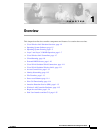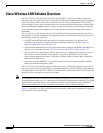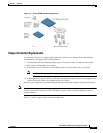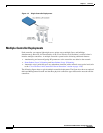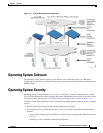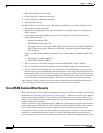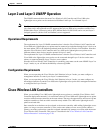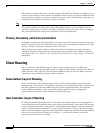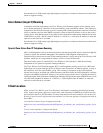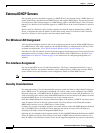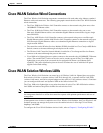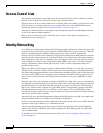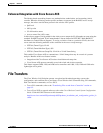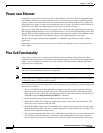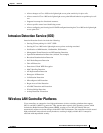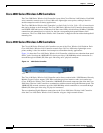
1-9
Cisco Wireless LAN Controller Configuration Guide
OL-8335-02
Chapter 1 Overview
Client Roaming
Note that the Cisco 1030 remote edge lightweight access points at a remote location must be on the same
subnet to support roaming.
Inter-Subnet (Layer 3) Roaming
In multiple-controller deployments, the Cisco Wireless LAN Solution supports client roaming across
access points managed by controllers in the same mobility group on different subnets. This roaming is
transparent to the client, because the session is sustained and a tunnel between the controllers allows the
client to continue using the same DHCP-assigned or client-assigned IP Address as long as the session
remains active. Note that the tunnel is torn down and the client must reauthenticate when the client sends
a DHCP Discover with a 0.0.0.0 client IP Address or a 169.254.*.* client auto-IP Address or when the
operator-set user timeout is exceeded.
Note that the Cisco 1030 remote edge lightweight access points at a remote location must be on the same
subnet to support roaming.
Special Case: Voice Over IP Telephone Roaming
802.11 VoIP telephones actively seek out associations with the strongest RF signal to ensure best Quality
of Service (QoS) and maximum throughput. The minimum VoIP telephone requirement of
20 millisecond or shorter latency time for the roaming handover is easily met by the Cisco Wireless LAN
Solution, which has an average handover latency of nine or fewer milliseconds.
This short latency period is controlled by Cisco Wireless LAN Controllers, rather than allowing
independent access points to negotiate roaming handovers.
The Cisco Wireless LAN Solution supports 802.11 VoIP telephone roaming across Cisco 1000 series
lightweight access points managed by Cisco Wireless LAN Controllers on different subnets, as long as
the controllers are in the same mobility group. This roaming is transparent to the VoIP telephone,
because the session is sustained and a tunnel between controllers allows the VoIP telephone to continue
using the same DHCP-assigned IP Address as long as the session remains active. Note that the tunnel is
torn down and the VoIP client must reauthenticate when the VoIP telephone sends a DHCP Discover with
a 0.0.0.0 VoIP telephone IP Address or a 169.254.*.* VoIP telephone auto-IP Address or when the
operator-set user timeout is exceeded.
Client Location
When you use Cisco WCS in your Cisco Wireless LAN Solution, controllers periodically determine
client, rogue access point, rogue access point client, radio frequency ID (RFID) tag location and store
the locations in the Cisco WCS database. For more information on location solutions, refer to the Cisco
Wireless Control System Configuration Guide and the Cisco Location Appliance Configuration Guide at
these URLs:
Cisco Wireless Control System Configuration Guide:
http://www.cisco.com/en/US/products/ps6305/products_installation_and_configuration_guides_list.ht
ml
Cisco Location Appliance Configuration Guide:
http://www.cisco.com/en/US/products/ps6386/products_installation_and_configuration_guides_list.ht
ml



